Defective aircraft carriers and their strange planes. Falklands and the Harriers
In 2018, the press got statement by Deputy Prime Minister Yuri Borisov that on behalf of the supreme commander in our country is the creation of a fighter with a short take-off and vertical landing (SCVVP). In fact, everything is somewhat more complicated, but Yu. Borisov did not begin to give any details then, and they are and have a meaning, but about them later.
This statement worked like an emergency valve. Immediately after him, a wave of publications broke through the press about how badly such a plane was needed, and immediately after ours the fleet An American fleet was set as an example, where universal landing ships are used as a tool for projecting force using short-take-off and vertical landing aircraft. A little later, as an example to imitate the Russian Navy, the Spanish UDC of the Juan Carlos type with the ubiquitous verticals was set.
The fleet on this subject is still silent. In the "Shipbuilding Program 2050" there is a certain "marine aircraft carrier complex", but without any details. Let's say right away, there is a certain consensus among military sailors that if you build an aircraft carrier, then normal and under normal aircraft. Alas, this point of view also has opponents. There are few of them, and they, as they are called, "do not shine." But the Internet is filled with calls to build large UDCs that can carry airplanes and develop vertical lines. This, incidentally, is also not just like that, and we will talk about this too.
Due to the fact that the idea of replacing a normal aircraft carrier with catapults and air finishers with an ersatz with vertically soaring reincarnations “Jacob” clearly found its supporters, it’s worthwhile to sort this out a bit. An idea that has mastered the masses may well become a material force, and if this is a wrong idea, then it is worth slamming it in advance.
Light aircraft carriers and their aircraft in wars
Immediately you need to separate the flies from the cutlets. There is a concept of a light aircraft carrier - carrier of air defense system. There is a concept of a large universal landing ship - the carrier of the air defense missile system.
So, these are DIFFERENT concepts. An aircraft carrier, even a light one, is designed to provide deployment aviation, including aircraft, as part of naval units. UDC is intended for landing. They replace each other equally badly, and this issue will be dealt with too. In the meantime, it is worth taking a light aircraft carrier and aircraft based on it with short or vertical take-off and vertical landing as a starting point. How effective can such ships be?
The effectiveness of an aircraft carrier ship consists of two components: the strength of its aircraft group and the ability of the ship itself to provide the most intensive combat work of the aircraft group.
Consider how light aircraft carriers and their air groups show themselves from this point of view in comparison with a normal aircraft carrier and full-fledged aircraft.
The most striking and intense example of the combat operation of such ships is the Falkland War, where light aircraft carriers and vertical take-off and landing aircraft (in fact, short take-off and vertical landing) were used by Great Britain. Some domestic observers saw in this the gigantic capabilities of the Harriers and their carriers. Representatives of the military scientific community added fuel to the fire. For example, thanks to the captain of the 1st rank V. Dotsenko, from one domestic source to another, the myth long ago exposed in the West of the alleged use of vertical thrust by Harriers in air battles wanders, which allegedly determines their success. Looking ahead, let's say: with all the training of the Harriere pilots, which was at a very high level, they didn’t use any such maneuvers, instead of maneuvering fights in the air, in the overwhelming case there were interceptions, and the success of the Harriers as interceptors was there and then was determined by completely different factors.
But first the numbers.
The British used two aircraft carriers in battle: the Hermes, which was once a full-fledged light aircraft carrier with a catapult and aerofinishes, and which was already built under the vertical lines of the Invincible. On board the Hermes, 16 Sea Harrier and 8 Harrier GR.3 aircraft were deployed. On board the Invincible, at first there were only 12 Sea Harriers. In total, 36 aircraft were based on two aircraft carriers. Subsequently, the composition of the air groups of ships changed, some helicopters flew to other ships, the number of aircraft also changed.
And the first numbers. The total displacement of the Hermes could reach up to 28000 tons. The total displacement of Invincible is up to 22000 tons. We can safely assume that with about such a displacement they went to war, the British had no one to count on, they brought everything they needed with them, and the aircraft on ships were sometimes more than normal.
The displacement of the two ships, thus, amounted to about 50 tons, and they provided a base for a total of about 000 Harriers and during combat work there were about 36 helicopters, sometimes a little more.
Wouldn’t it be better at the time to spend money on one aircraft carrier of 50 tons?
An example of an aircraft carrier with a displacement of about 50 kilotons is the British aircraft carriers of the Audacious type, namely the Eagle, which, according to the results of the modernization carried out earlier, had a total displacement of about 54000 tons.
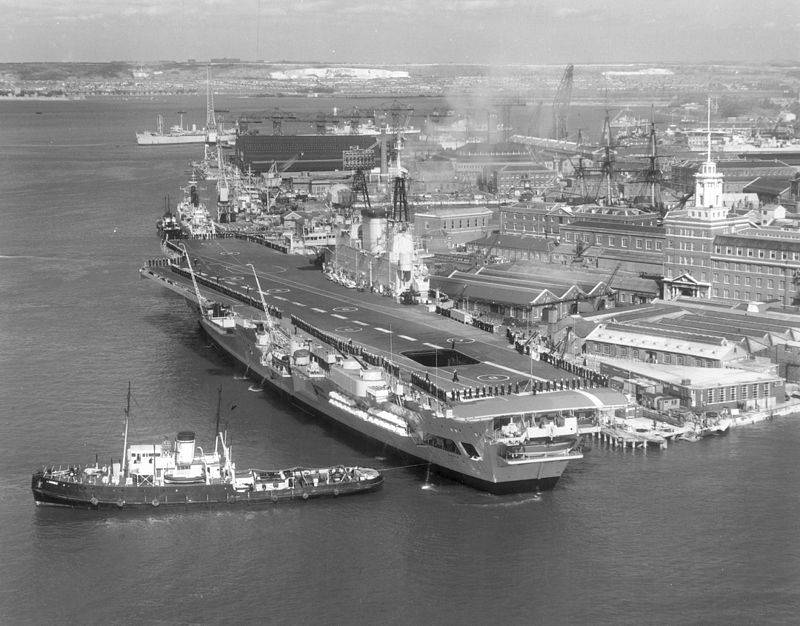
The typical Igla air group in 1971 included: 14 Bakenir attack planes, 12 Sea Vixen interceptors, 4 Gannet AEW3 AWACS aircraft, 1 Gannet COD4 transport aircraft, 8 helicopters.
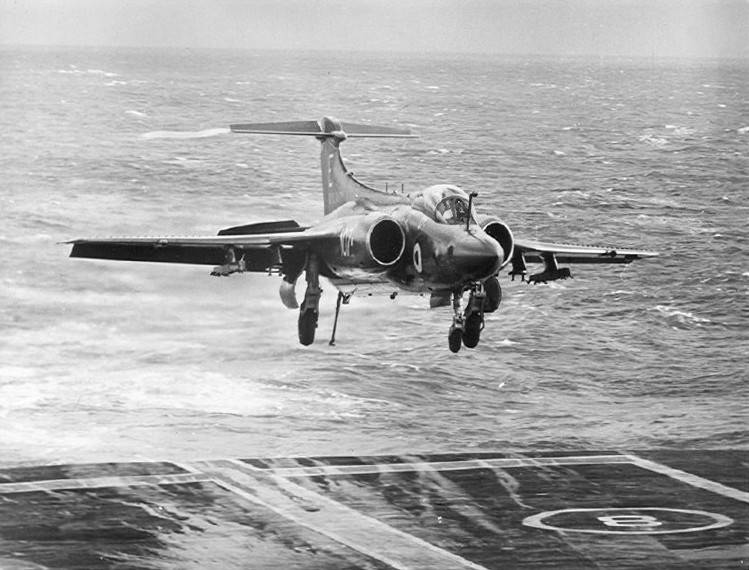
By that time, it was already substantially obsolete aircraft, but the fact is that the ship was tested as a carrier of F-4 Phantom fighters. They were successfully launched from this ship and successfully landed on it. Of course, regular flights required additional modernization of catapults and gas deflectors - the Phantoms did not keep the regular hot exhaust, they needed liquid cooling.
Video with flights from the Deck of the Needle, including flights of the English Phantoms:
However, then the British decided to save money and cut their large aircraft carriers so that in just a few years they could lay down several new ones, albeit half as much. How many Phantoms could such a ship carry?
More than two dozen, this is unique. Firstly, the dimensions of the Bacenirs and Phantoms are comparable: the first has a length of 19 meters and a wingspan of 13, the second - 19 and 12 meters. The masses were also about the same. This alone suggests that the “Backeners” could be replaced by “Phantoms” as 1: 1. That is 14 “Phantoms”.
The Si Vixen was two meters shorter, but wider. It is difficult to say how many “Phantoms” would fit in the space that they occupied on the ship, but how much would fit exactly, no doubt. And there would still be five different “Gunnets” and 8 helicopters.
Again we ask ourselves the question: is a transport “Gannet” needed on such an expedition as the war for the Falklands? No, he has nowhere to fly. Thus, the place for the Phantoms among the British could be vacated by 12 Sea Vixen and one transport Gannet. A minimum of 10 "Phantoms" instead of them on board the ship would fit with a guarantee. What would make the following air group possible: 24 Phantom GR.1 multi-role fighters (British F-4), 2 search and rescue helicopters, 6 anti-submarine helicopters, 4 AWACS aircraft.
Let's count one more thing. “Gannet” with the wing folded was placed in a rectangle measuring 14x3 meters, or 42 square meters. Accordingly, 4 such aircraft - 168 "squares". This is a little more than you need to base one E-2 Hokai. Someone may say that one AWACS aircraft would not be enough, but in reality the British with their two light aircraft carriers AWACS did not have at all.
Moreover, an analysis of the performance characteristics of Argentinean aircraft could well have made it clear to the British that they would not attack targets at night, which would drastically narrow the time when the Hokai was needed in the air. In fact, the temporary “window” into which Argentina could massively attack British ships was “dawn + flight time to Falkland and minus flight time from base to coastline” - “sunset minus the time of return from Falkland to coastline”. With daylight in the spring in those latitudes at only 10 hours, this made it possible to really get by with one Hokai.
Moreover, the "Phantoms" the British bought. Could such a ship be modernized to accommodate normal AWACS aircraft on it? If you start only from the displacement, then probably yes. The Hokai carried ships much smaller in size and displacement. Of course, the height of the hangar, for example, could make adjustments, as well as the size of the lifts, but the same Americans are quite practicing deck-based aircraft parking, and there is no reason to believe that the British could not do the same.
True, the catapult would again have to be redone.
The meaning of all this is as follows. Of course, the Eagle with the AWACS on board looks a bit fantastic, but we are not interested in whether it would be possible to put it there, but how we could manage 50 thousand tons of displacement.
The British “made” of them two ships capable of carrying 36 Harriers, in the limit of about forty, zero AWACS aircraft and a significant number of helicopters.
And if in their place there would be a full-fledged 50000-ton aircraft carrier, and even, for example, the old man "Odessa" not remodeled a hundred times, but a specially built ship, for example, offered by CVA-01, then instead of the "Harriers" the Argentines will the place would have met several dozens of Phantoms with the corresponding combat radius, patrol time, the number of air-to-air missiles, the quality of the radar and the ability to fight. Perhaps, with the American AWACS aircraft, in the case of a specially built aircraft carrier - not one.
Again, we give an example: in addition to 26 combat aircraft, the French “Charles de Gaulle” has 2 AWACS aircraft, and it is 42500 tons. Of course, it is dishonest to compare a nuclear carrier with a non-nuclear one, it does not have the volumes occupied by marine fuel, but this is still significant.
Which is stronger: 24 Phantoms with a supply of missiles and fuel for air combat and, possibly, with an AWACS aircraft, or 36 Harriers, each of which can carry only two air-to-air missiles? What forces could form stronger air patrols? This is a rhetorical question, the answer is obvious. By the ability to patrol the Phantom, in the worst case scenario, he could spend at least three times as much time in the air (actually even more) than the Harrier, when flying from the deck he could have six air-to-air missiles and one outboard fuel tank. If we assume that by the time of patrolling he alone replaces three Harriers, and also three missiles (Harrier could not have more than two then), then to replace one Phantom, nine Harriers were needed, and it would be a poor and unequal replacement, taking into account at least the Phantom radar and LTH.
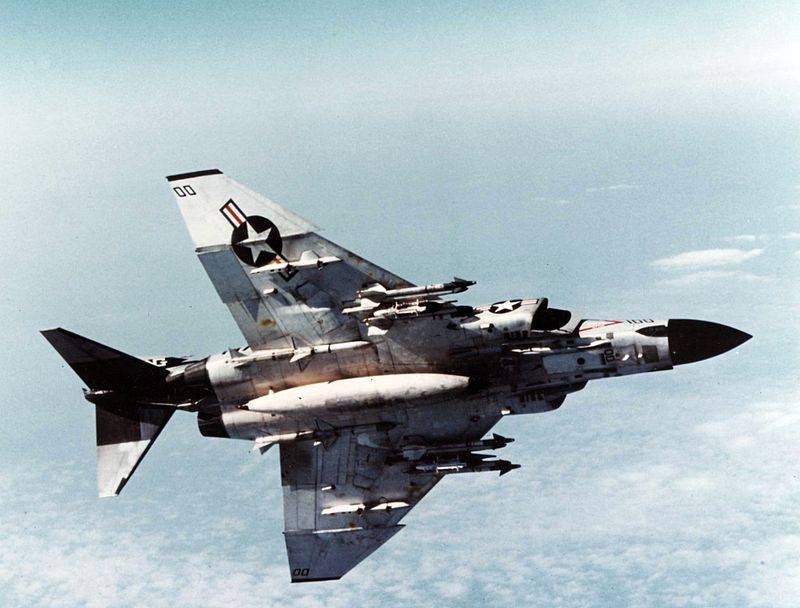
"Phantoms" would solve the air defense tasks of the English forces over the strait with a much smaller outfit of forces, firstly, with the removal of the line of interception for tens of kilometers from the ships, this is secondly, and with large losses of Argentines in each departure - thirdly. This is undeniable. It is also indisputable that one Phantom, when performing percussion tasks, would replace several Harriers.
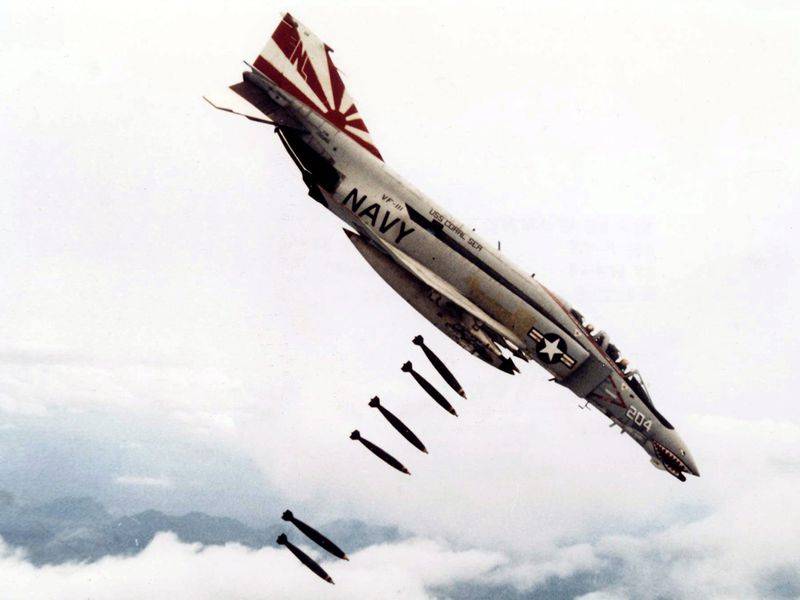
Now about how the ships themselves could support the tactical and technical characteristics of aircraft.
Active air operations during the Falkland War continued for 45 days. During this time, according to British sources, Sea Harriers completed 1435 sorties, and GR.3 Harriers completed 12, which in total gives us 1561 or a little less than 35 sorties per day. A simple calculation should, in theory, tell us that this is 17,5 sorties per day from each aircraft carrier.
But this is not so. The fact is that some part of the combat missions "Harrieres" performed from the ground.
Because of the clearly small combat radius, the British had to urgently build a temporary airfield on one of the islands of the archipelago. According to the original plan, it was supposed to be a refueling point at which aircraft would be refueled when operating outside the combat radius when flying from an aircraft carrier. But sometimes the Harriers carried out combat sorties directly from there, and these sorties also fell into statistics.
The base was designed for 8 sorties per day, when a reserve of material and technical means was created for it, and began to operate from June 5. From this day until June 14, as stated in English sources, the base "supported 150 sorties." How many departures were made from the base, and how many landings there were for refueling, open sources do not indicate, at least, reliable ones. It is unlikely that this is classified information, simply, most likely, no one made data summaries.
Thus, the average daily 17,5 is not typed. The hottest for the Harriers was the day May 20, 1982, when all planes from both aircraft carriers completed 31 sorties. And this is the record of that war.
There is a "flawed" number of sorties, which could be provided by carrier ships of the "verticals". And this is logical. Small decks, insufficient space for repairing aircraft, plus the quality of these aircraft themselves led to this result. Compared with the American aircraft carriers, which easily “mastered” more than a hundred sorties per day, and the sorties of normal planes, each of which replaced several Harriers, the results of the British are simply nothing. Only the weakness of the enemy acting against them gave them the opportunity to achieve any significant results at the cost of such efforts. However, most sources indicate that the Harriers have performed well. It is worthwhile to make out this statement.
Super-successful Harrier
In order to understand why the Harriers have shown themselves as shown, it is necessary to understand in what conditions, how and against which enemy they acted. Just because the key to the success of the Harriers is precisely in the enemy, and not in their qualities.
The first factor is that the Argentines did not carry out air battles. Maneuverable aerial combat requires fuel, especially when it comes to maneuvering a nimble aircraft and you need to perform several turns or when the afterburner is to be put into operation.
The Argentine pilots never had such an opportunity. All those Russian-language sources that describe some kind of "dump" between the Argentine pilots and the English "vertical", give false information.
The situation in the air for almost the entire war was as follows. The British assigned a zone over their ships, limited in size and height, all aircraft in which, by default, were considered enemy and which opened fire without warning. “Harriers” had to fly over this “box” and destroy everything that enters it (rarely happened) or exits (more often). Inside this zone, ships worked for Argentines.
The Argentines, having no fuel to fight, simply flew into this “box”, made one approach to the target, dropped all the bombs and tried to leave. If the Harriers managed to catch them at the entrance to the zone or at the exit from it, then the British recorded their victory. The attacks of the Argentines were carried out at heights of a few tens of meters, and the Harriers at the exit from the zone, having a warning from surface ships about the target, attacked the Argentines in a dive from a many kilometers high. It is naive to think that under such a scenario of the battle some kind of “dumps”, “helicopter tricks” and other fiction, which has been fed the domestic reader for many years, were possible. Actually, checks from English sources speak directly about everything.
Everything, there was no more air war over the British fleet. No vertical drafts or other fabrications of Russian writers. It was different: the British knew the place and time where the Argentines would fly, and waited for them there to destroy. And sometimes they destroyed it. And the Argentines could only hope that the SAM, the turn from the cannon or the Sidewinder would not go to them this time. They had nothing else.
This, to put it mildly, cannot be considered an outstanding success, rather, on the contrary. How many British lost their ships characterizes the actions of the Harriers, which, we repeat, no one countered, not from the best side.
Especially worth mentioning is the ability of Argentines to plan military operations. So, they never managed to synchronize the strike of several groups of aircraft in time, as a result of which even ten aircraft did not immediately go out onto English ships at once. This in itself could not lead to anything but defeat. The synchronization of aviation operations is not an easy task, especially when striking at the ultimate combat radius.
But on the other hand, no one bothered the Argentines, they flew freely over their territory. Another example is wretched intelligence. So, the British landing was discovered only after the fact, when the soldiers were already on the ground. This is, frankly, amazing. The Argentines did not even have elementary observation posts of several fighters with a walkie-talkie. Not even messengers on motorcycles, jeeps or bicycles. They simply did not monitor the situation.
And even in such conditions, the performance characteristics of the Harriers worked against them. So, there was a case of a plane crashing into the water due to the full production of fuel. Twice, the Harriers were not able to reach the aircraft carrier, and they were put on Interport and Fireless landing ships for refueling.
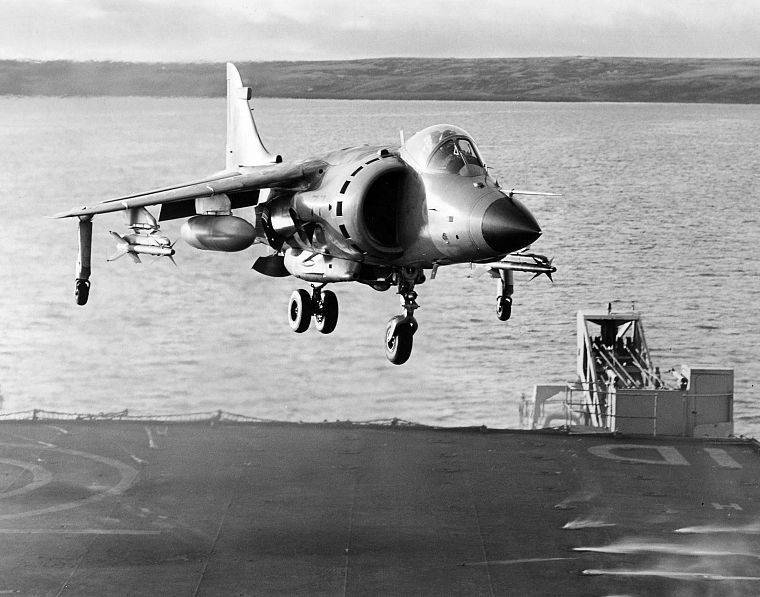
Harrier’s combat flight time could not exceed 75 minutes, of which 65 took a flight from an aircraft carrier to the area of combat use and vice versa, and only ten remained to complete the combat mission. And this despite the fact that none of the Sea Harriers could carry more than two air-to-air missiles — the other two underwing suspension units occupied the suspension tanks, without which these modest figures would not have been possible.
To ensure the expansion of these modest combat capabilities, the British immediately after the landing began the construction of the already mentioned ground airdrome for refueling aircraft. Domestic sources managed to deceive here too, having spread information that this temporary airfield had a runway length of 40 meters, while in fact the San Carlos Forward Operation Base had a runway length of 260 meters, from forty “Harrier” would have taken off only without load and flew away would be close. This refueling point made it possible to somehow increase the combat radius of the Harriers. One can only wonder at the English pilots who were able to show something in these conditions.
By the way, if the enemy had at least some kind of military intelligence, the Daggers could break through to this airfield - at least once.
The Harriers, of course, made a decisive contribution to the victory of the British. But we must understand that this is largely due to just a combination of factors, and nothing more.
But the presence of the British several dozen normal fighters would change the course of hostilities in a much more substantial way - and not in favor of Argentina.
Many years after the war, the British estimated that on average one Sea Harrier made 1,41 sorties a day, and one Harrier GR.3 made 0,9.
On the one hand, this is close to how the Americans fly from their aircraft carriers. On the other hand, Americans with dozens of full-fledged cars on each ship can afford it.
But British naval pilots during the times of Korea and the Suez crisis showed completely different numbers - 2,5-2,8 sorties per day. The Americans with their four catapults on the ship, too, by the way, can, if they want. Could the Harriers from their tears of small decks surpass their own results - an open question. Because in no subsequent war did they show even this.
It's time to admit a simple fact: any other aircraft and any other aircraft carriers would have shown themselves at the Falklands much better than what was really used there from the British side. The British “rode out” on an amazing mixture of their professionalism, personal courage, perseverance, the enemy’s weakness, the geographical features of the theater of war and amazing luck. The absence of any of these terms would lead Britain to defeat. But the performance characteristics of aircraft and ships have nothing to do with it. The commander of the British forces, Vice Admiral Woodward, did not in vain doubt the victory to the very end - he had reasons to doubt it.
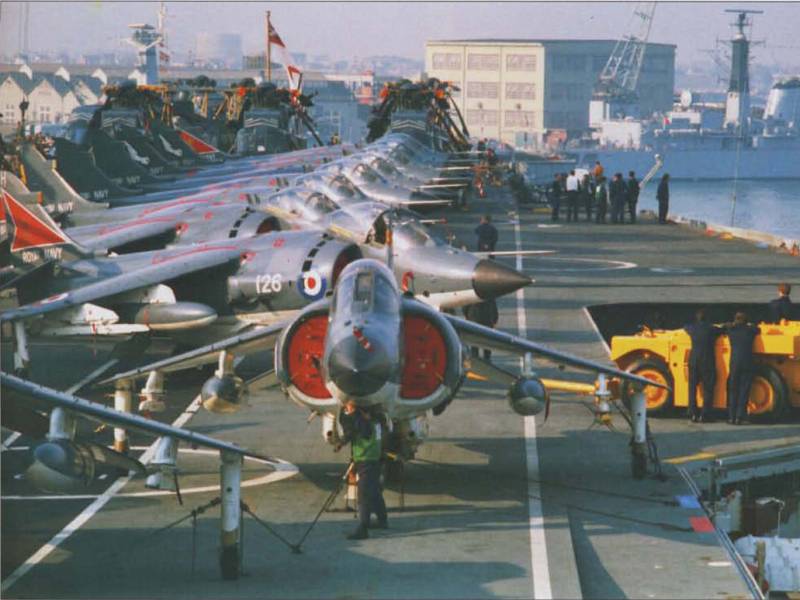
Here's how to really evaluate the actions of British light aircraft carriers and aircraft in that war.
They won despite their military equipment, and not thanks to it.
Oh yes. We have forgotten something. The British were in a hurry to finish before the storms in the South Atlantic. And they were right.
The storm factor in relation to light and heavy aircraft carriers deserves a separate analysis.
To be continued ...
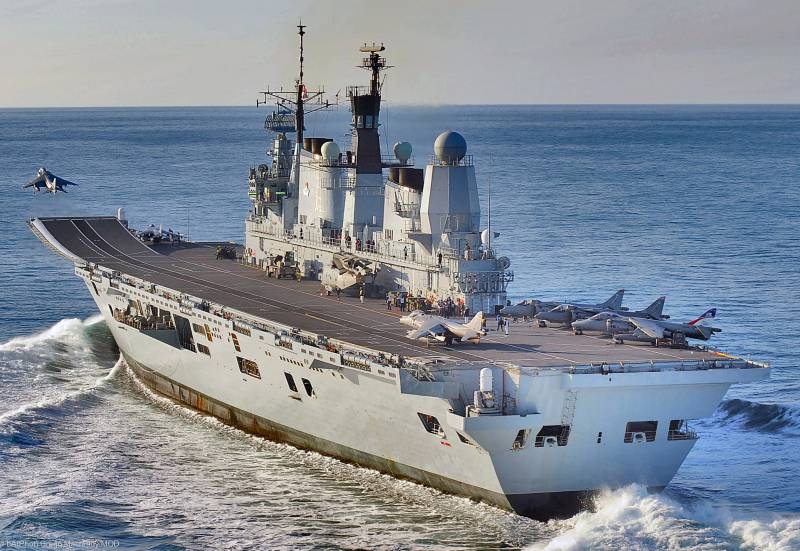
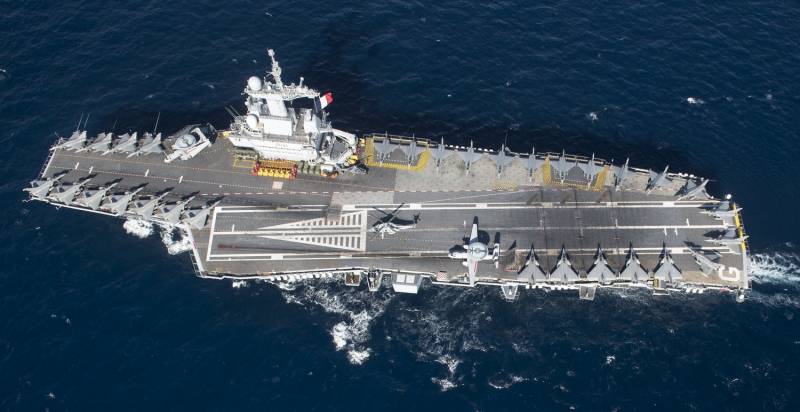

Information